Nervous System Hookup Leads to Telepathic Hand-Holding
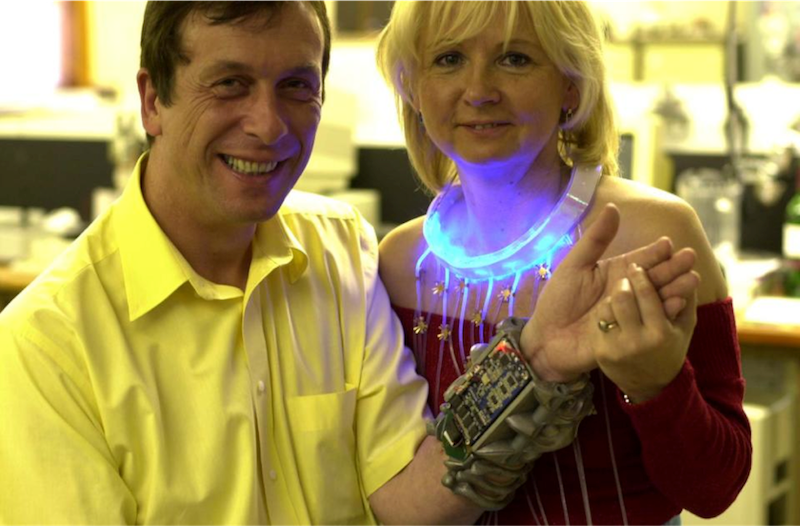
Irena wears a necklace that changes color based on signals from Kevin’s nervous system. (Photo: Kevin Warwick)
We all know couples who seem to communicate telepathically. They order for each other at restaurants; their raised-eyebrow language is indecipherable to outsiders; they disappear from parties together with barely a nod. But what happens when those pesky sensory middlemen get cut out entirely? What does it feel like? Is telepathy the future—or a completely false category?
Thirteen years ago today, one couple wired their nervous systems together and tried to find out.
The fact that this couple includes Kevin Warwick makes it somewhat less surprising. Warwick, currently a Professor of Cybernetics at the University of Reading in England, has spent decades cultivating a reputation as the world’s foremost aspiring cyborg. The nervous system connectivity test was just one of a series of experiments in pursuit of that goal.
In March of 2002, two months before the nerve hookup, Warwick was surgically implanted with a hundred-electrode array designed to pick up signals from his nervous system. The pea-sized gizmo was stuck into a nerve cluster just below his left wrist, and connected to an external electrical terminal by wires threaded through his arm. Impulses jumped from his nerves into the array, fizzed through the wires, and ended up in the terminal—where Warwick could translate them into other types of communicable signals, and receive signals back.
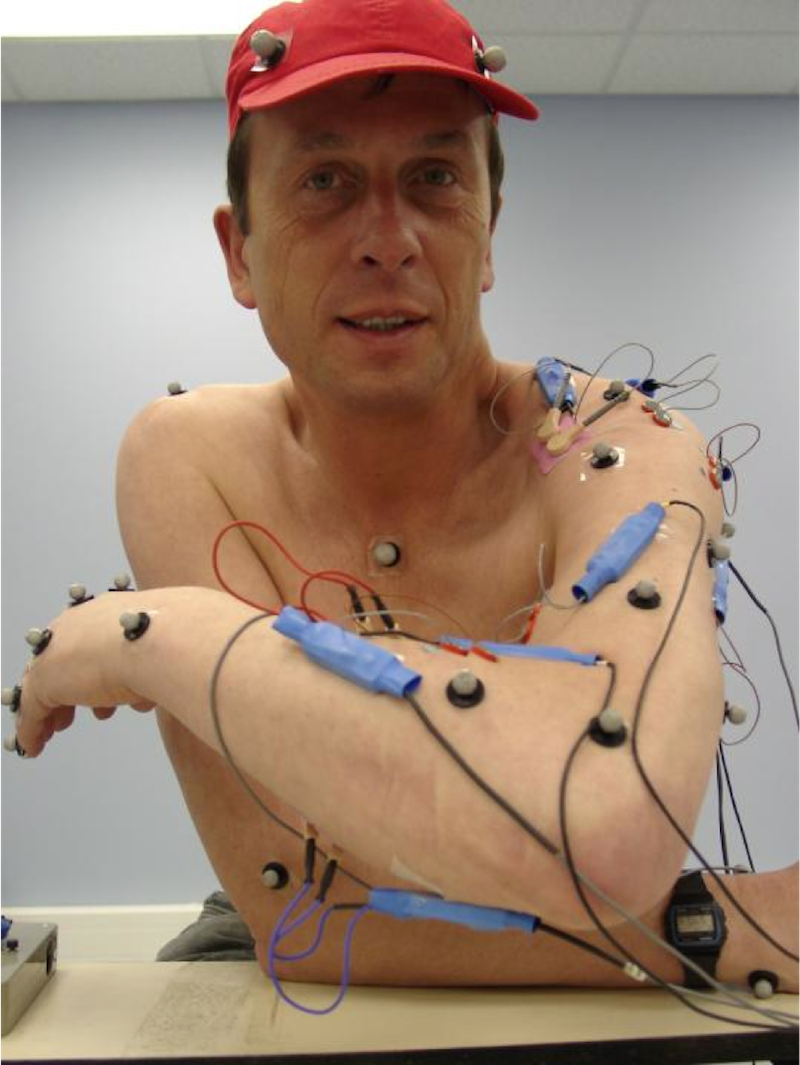 Spring 2002: Kevin Warwick gets his visual and muscular systems mapped at Oxford University, to help his implant get used to its new body. (Photo: Kevin Warwick)
Spring 2002: Kevin Warwick gets his visual and muscular systems mapped at Oxford University, to help his implant get used to its new body. (Photo: Kevin Warwick)
Warwick used this setup to do a bunch of neat tricks. He controlled a robotic hand, for example, and felt what it was “feeling”—“we were able to have signals sent back from the hand as well, so I was able to experience force, pressure, [and other] sensations,” he explains. He also took advantage of the internet’s distance-shrinking properties to extend his powers across the ocean, flexing a UK robot’s hand from a laboratory at Columbia University in New York. By hooking his implant up to ultrasonic sensors, he tapped into what he describes as “a basic new sense” similar to the one bats use to navigate in the dark.
“At one point, one of the researchers brought a big board very quickly toward me—I couldn’t see it because I had a blindfold on, but I could sense it ultrasonically,” he says. “It was very scary.”
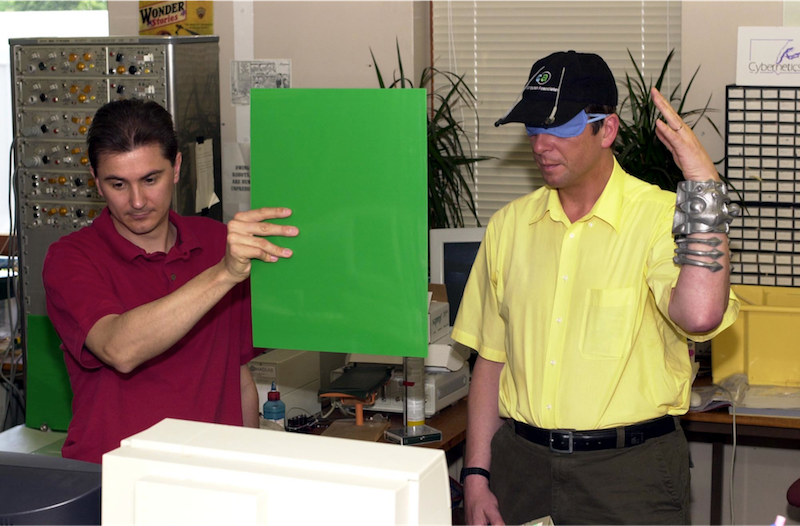 Warwick’s new sense warns him of this approaching sheet of cardboard. (Photo: Kevin Warwick)
Warwick’s new sense warns him of this approaching sheet of cardboard. (Photo: Kevin Warwick)
When one of his experiments required a second flesh-and-blood creature rather than a bot, his wife, Irena, volunteered. She had a smaller electrode array put in at a matching spot, and they routed the sensors through the Internet and started blipping at each other.
“Very simply, we just connected up our nervous systems together,” Warwick says. “Every time she opened or closed her hand, I was receiving pulses.” The original paper reports the pulses came through with greater than 98 percent accuracy—only slightly less reliable than a traditional hand squeeze.
 June 10th, 2002: Kevin and Irena Warwick show off their his-and-hers electrode arrays. (Photo: Kevin Warwick)
June 10th, 2002: Kevin and Irena Warwick show off their his-and-hers electrode arrays. (Photo: Kevin Warwick)
Sophistication-wise, though, this type of nerve-to-nerve communication is more like an indecipherable shout across a field.
“We were doing it in a very simple sense, like Morse code,” Warwick explains. “It didn’t treat the signals from my wife as being pain or heat or anything like that.”
Because she hadn’t had the two-month head start enjoyed by her husband, Irena’s brain’s translation was even more makeshift. “Every time I closed my hand, she described feeling ‘lightning in the palm of her hand,’” Warwick says. “Her brain was having to make some sense of the signals as they came in, and that was the sense it made of them.”
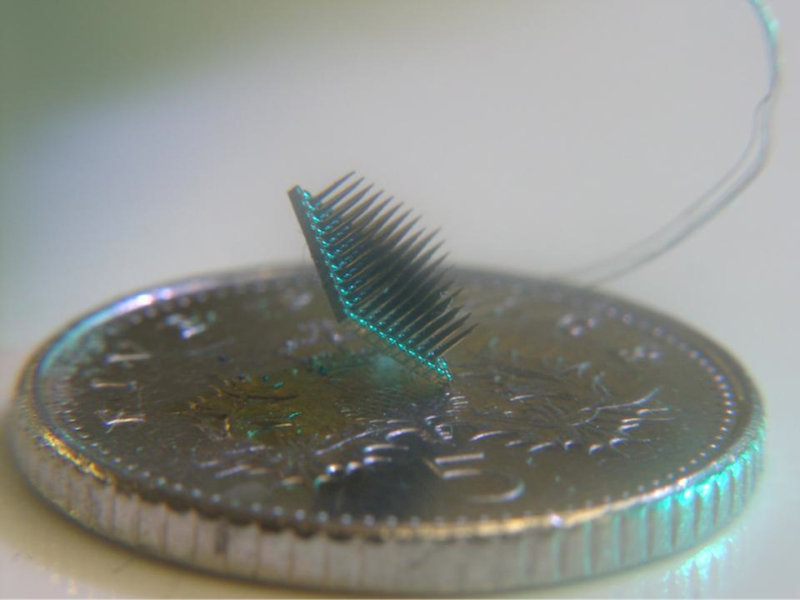 The Utah Array: a very small, very sharp-looking hundred-electrode array that gave Kevin Warwick a different way to interface. (Photo: Kevin Warwick)
The Utah Array: a very small, very sharp-looking hundred-electrode array that gave Kevin Warwick a different way to interface. (Photo: Kevin Warwick)
Warwick has a penchant for flashy experiments. Four years before the 2002 electrode implant, he stuck a simpler chip in his arm and turned himself, essentially, into a walking remote for home appliances—doors opened as he approached, his computer greeted him by name, and he could turn lights on and off with a flick of his wrist. He has made headlines for building a robot deemed too scary for minors, trying to bring a electronic cat named Hissing Sid onto a British Airways flight, and, most recently, for claiming that a rudimentary chatbot passed the Turing Test.
These showcases, combined with a knack for dire predictions about the eminent rise of artificial intelligence, have garnered Warwick a lot of critics. One British newspaper dubbed him “Captain Cyborg,” and some especially devoted skeptics once ran a website called Kevin Warwick Watch dedicated to chronicling his more extreme claims.

Kevin Warwick eyes the robot hand he is controlling with his brain. (Photo: Kevin Warwick)
Warwick’s experiments, critics say, can only be considered breakthroughs if we accept a very limited definition of “direct communication.” Living things have been transmitting information through various media for millennia. Why is it cool or useful to dial back down to electrical impulses—especially when, in doing so, you gain no speed or finesse?
Professor Inman Harvey, of the University of Sussex’s Centre for Computational Neuroscience and Robotics, explains his issues with Warwick thusly:
“Right now my nervous system is causing my fingers to tap on keys, interfacing with a computer. Through the wonders of the internet, this will cause symbols to appear on a computer screen in front of you, patterns of light go through your eyes and at your retina these interface with your nervous system. Bingo, thought communication by interfacing each nervous system with a computer. [I relay] some specific thought of mine—“pink elephant”—and I am confident a version of that thought reaches you … is the “directly” aspect important? Well, clearly it is potentially important for some disabled people, but I fail to see any scientific interest at the moment.”
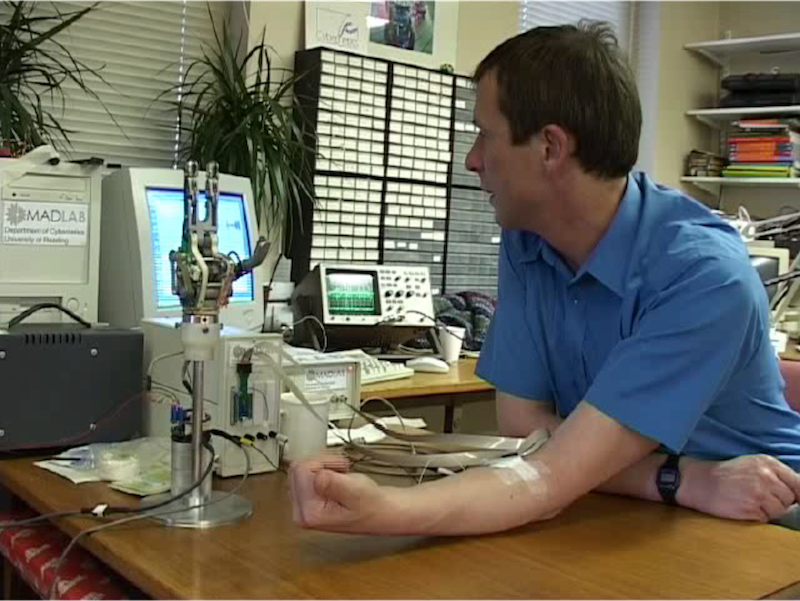
Kevin Warwick and the robot hand seek a truce. (Photo: Kevin Warwick)
When asked, Warwick expresses hope that “connecting” with his wife was indeed the first step towards something bigger.
“For me, this was the highlight of the whole experiment,” he says; indeed, of all the experiments he has done, it’s still his favorite. “I think in years to come… people will at some stage be thinking to each other. It’s the next step, ultimately it’s just how long it takes.” (Plus, he says, it might help us keep up with those hyper-intelligent, super-connected robots he thinks are just around the corner: “If you can’t beat it, join it.”)
Perhaps even more interestingly, Warwick found the nerve hookup to be a categorically different communication experience: “I have to say, something that surprised me when we were hooked up, it is a very intimate thing,” he says. “You’re actually linking your nervous system together with somebody else’s nervous system. And when you think of what’s involved in sex, sex is quite intimate, but it’s not this intimate! This really is—you’re getting the insides of your body hooked up together. So in a way, I’m glad it was my wife—if I’d have done it with another woman, I think it could have really caused problems.”















Follow us on Twitter to get the latest on the world's hidden wonders.
Like us on Facebook to get the latest on the world's hidden wonders.
Follow us on Twitter Like us on Facebook